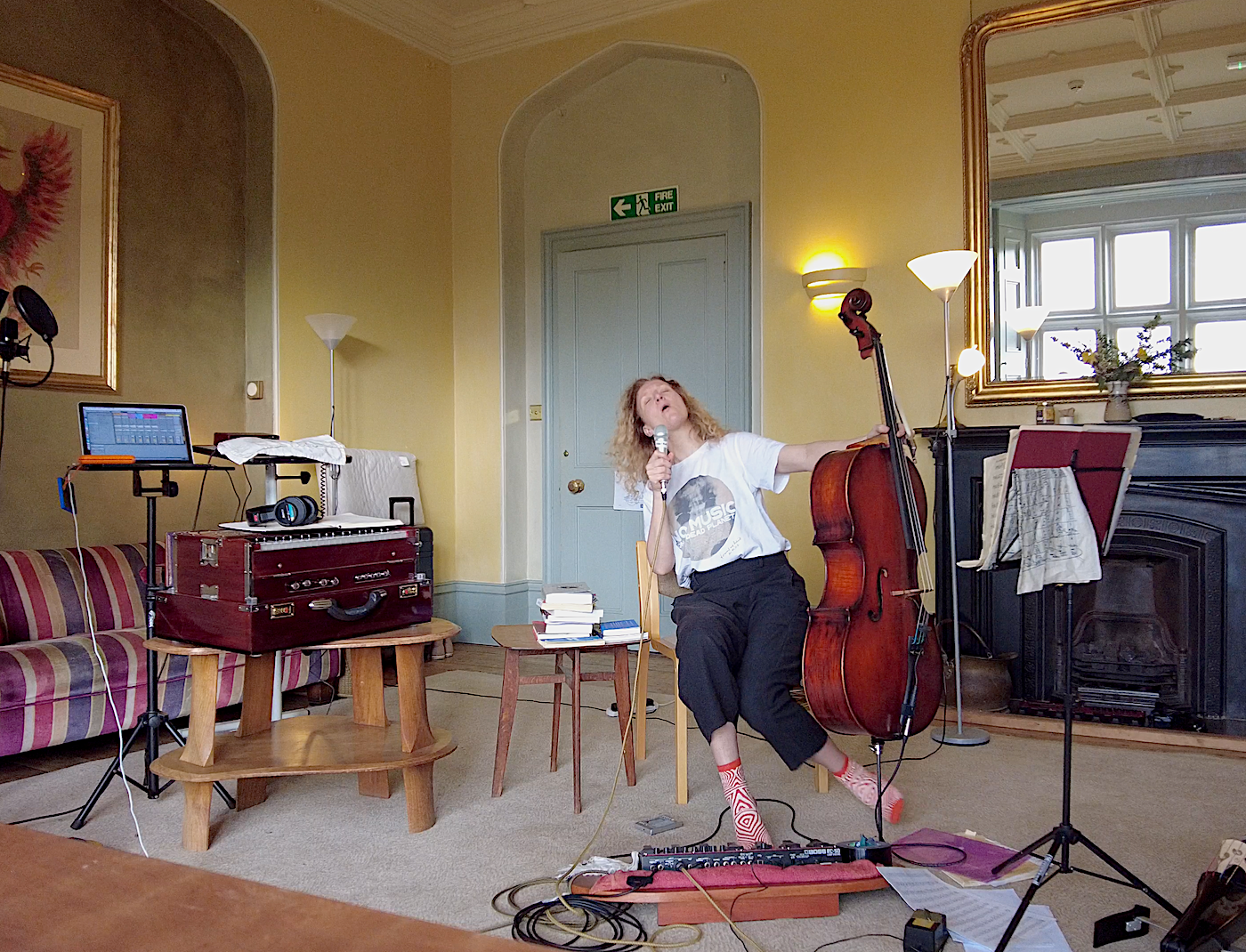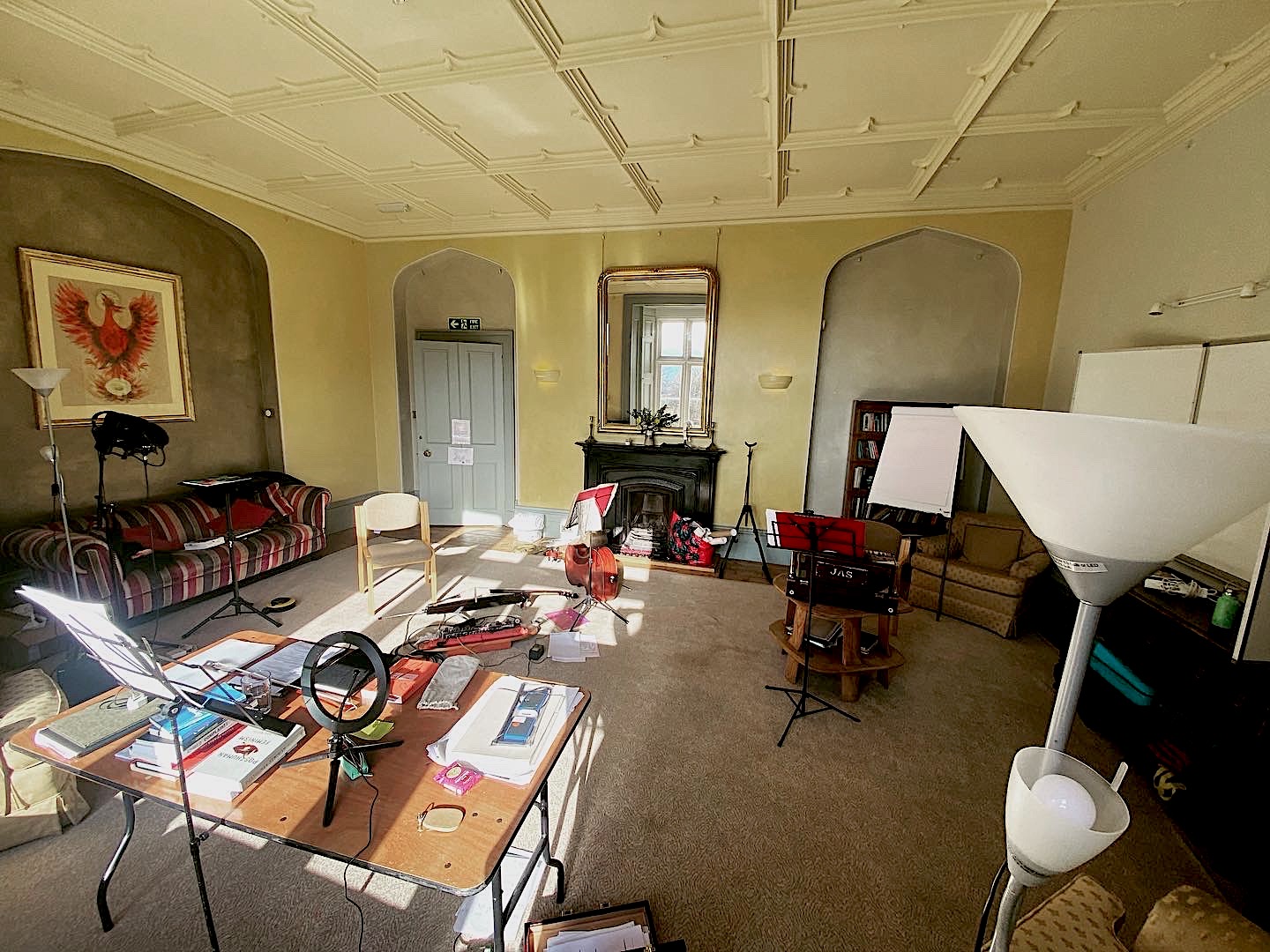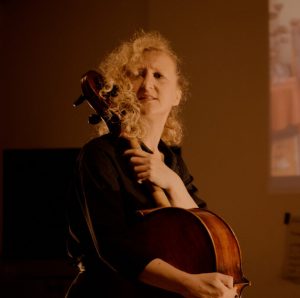Artist Residency at Hawkwood: Anna-Helena McLean
"The environment in which I work is as much a part of my process as the process itself."
I came to Hawkwood to crack open the content for a new music theatre work called Orlando Descends. It is a work built of layers: embodied training, lived experience and textual material.
I explore these layers in phases, working responsively with others and through ‘physiovocality’ – which is a term that points toward vocal techniques that reveal the dramaturgical life of a text to the performer. Physiovocality allows for both psychological ‘realism’ and the plurality of lived experiences.
When I am not able to work with a trained ensemble, I position myself with all the tools of play in an empty space. I then set about animating research activities to act on my imagination through very specific source materials. Sinking into this embodied research I am gradually able to observe what might be called my ‘psychophysical’ responses to the stimuli, test driving as it were the ideas I intend to bring to my company in rehearsal. I implement my physiovocal training to guide this process deeper into the source material than my logical, conceptual enquiry alone accounts for.
For those unfamiliar with psychophysical approaches to devising, it is a practice that could be easily compared to that of a painter. The painter might set about a project observing a landscape for example. She begins to paint what she sees according to certain rules that she is familiar with. Through the act of painting she comes to know more and more about both her desire to paint and the qualities of the subject she is painting. Both lived experiences inform each other at the same time and these are not necessarily conscious. The technical process of painting is therefore an act of synthesis. The product of this painting process becomes infused with a consciousness of its own and which is, at best, quite beyond the total control of the artist.
By moving fluidly and with intention between selected text sources, sounds, rhythms, songs, recordings and reading, I set about documenting what appears and I notate this in multimodal formats. I then go back over these documents to filter them through my conceptual framework for analysis. For example, I asked myself, ‘To what extent does vocality become a feminist tool of agency when researching the underwritten experiences of women in the Laboratory?’, then ‘How might a performance about self-transformation expose Gardzienice’s Mutuality as a form of vocal touch?’ and therefore ‘How does sound operate in the text of Orlando, and to what extent does sound cause the act of self-transformation in chapter 3?’. In this way I learn also about how to approach the oldest sung epic known to humanity, ‘The Descent of Inanna’ (which is my secondary text source to Orlando).


I capture emerging ideas, themes and pictures in mp3 recordings, through my loop pedal and Ableton Live software, on a DJI pocket 2 camera, in new writing and critical written reflections, as well as note-taking on a flip chart and noting musical motifs on manuscript paper. Acting as my own third eye I incrementally set about putting names on the leading ideas that appear to generate a particularly affecting ‘resonance’. Opening a gateway into the energetic subconsciousness of the text, synthesising the different parts or ‘layers’ I originally set out with. If I am able to focus for long enough, these ‘points of resonance’ form the architecture of an imaginative world, allowing me to move into streams of consciousness with the source materials and the given layers I started with. There I can sometimes write out sequences that make up a dramaturgical score. I can step in and out of it, one moment singing and playing, next speaking, then developing movement, writing or noting down imagery.
This week I did get to a point where I was able to slip into the first few scenes of the performance. I could see it all around me, feel and hear it. I understood the spatial dimensions of it and could feel the quality of the sounds that needed to exist there. Knowing what those sounds might be I could then better understand how to produce them technically. That enables me to generate tasks to set to the production team and locate the skills or equipment the production will need to support our rehearsals and I can relay these suggestions later in the process.
The eventual piece will be presented as part of a Britten Pears Artist Residency in the Britten Studio at Snape Maltings. It will also act as part of my doctoral research project enquiring into progressive models of feminist ethical practice in the post-Grotowskian laboratory.
The environment in which I work is as much a part of my process as the process itself. I revelled in the location at Hawkwood; the views, the woodland running paths, the comfortable bed, unimaginably delicious food and most of all the stimulating conversation and empowering, uplifting company. Being at Hawkwood amidst other artists was a whole project in itself and I cherished every single moment and meeting. I’ve made long-term friends and I found focus and collaboration in connecting with the artists in residence that same week.
The influence the residency will have on your work in the future:
I found it difficult to leave. Hawkwood gave me a taste of the artist I want to be when I have the support, time and space to live in and with my creative practice with my core team on standby. It reminded me of a way of life I have not known since leaving Poland; the 24/7 access to space I had there, unlimited attitude to practice and that celebrated everything artists do. All framed by the vast healing of nature behind every door. This residency was the perfect way to open the first page on this new production. It showed me the artist I am ready to be as soon as the conditions are there. It gave me the chance to see, visualise and begin manifesting the imaginative architecture of my work as I want it to be. The residency showed me a way of working and being that is ideal and that is achievable in the UK and now I know it exists I can help to keep finding it again and again until it is my reality once again.
Original Blog Entry by Anna McLean.
With thanks to the Francis Reckitt Art Trust, DCMS & Arts Council England for their funding that make these residencies possible. Read about our Artist Residency Programme here.
Anna-Helena McLean

Anna-Helena read Drama and Music at Royal Holloway University of London with a specialism in solo cello and performance. She is an established music theatre and ensemble coach, composer and director, running her unique approach to acting and voice training called the ‘Actor – Chorus – Text’ (ACT) Ensemble Practice since 2007. Now a world-class independent and feminist actor training methodology, ACT INTERNATIONAL runs out of an Italy-based centre (Centro Anidra) offering rigorous training programmes to international applicants every summer.
Formerly a principal of the Gardzienice Theatre Association in Poland (2000-2007), Anna-Helena played the lead in Metamorphoses & Electra and toured worldwide (LaMama ETC NYC; Meyerhold Centre Moscow; Getty Centre L.A; Barbican London) as well as leading an Ancient Greek Orchestra (Orkiestra Antyczna) and the Academy for Theatre Practices (APT) in Gardzienice.
Anna-Helena is currently engaged as a Doctoral Candidate in Performance Practice at Guildhall School of Music & Drama and was most recently a Voice Tutor on the Acting Studies BA Hons course also at Guildhall. She is also a supervisor for MA students in Classical Acting at Central School of Speech and Drama and guest lectures at Rose Bruford College since 2020.

